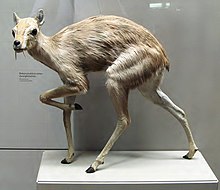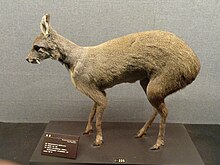Musk deer
| Musk deer | ||||||||||||
|---|---|---|---|---|---|---|---|---|---|---|---|---|

Siberian musk deer ( Moschus moschiferus ) |
||||||||||||
| Systematics | ||||||||||||
|
||||||||||||
| Scientific name of the family | ||||||||||||
| Moschidae | ||||||||||||
| JE Gray , 1821 | ||||||||||||
| Scientific name of the genus | ||||||||||||
| musk | ||||||||||||
| Linnaeus , 1758 |
Musk deer (Moschidae) are one with the horn carriers (bovidae), so with antelopes , caprine and cattle , related family of cloven-hoofed animals . Originally they were believed to be related to deer : in older literature they were often referred to as musk deer and considered the original subfamily of deer. Unlike the deer, they have a gallbladder and the udder of the females only has two instead of four teats. In addition to the eponymous musk gland and another tail gland, the musk deer have elongated upper canine teeth, but there are no facial glands and antlers.
Musk deer live mainly in wooded and alpine bush habitats in the mountains of South Asia, especially in the Himalayas . The first occurrences in Europe were in the Oligocene ; today, however, they are extinct there.
features
All musk deers are so similar to one another that they are occasionally thought of as a single species. Their head-torso length is 70 to 100 centimeters, the shoulder height 50 to 80 centimeters, the weight 10 kilograms and the tail is between 1.8 and six centimeters long. The hind legs are well developed in all species, the topline sloping forward because the hips are higher than the withers. The coat color is predominantly dark brown, but also varies within the species. They have white spots on the chin, sides of the throat, and the inside of the legs. The ears are long in relation to the body and head size. Unlike deer, musk deer do not have antlers. It is noticeable that the upper canine teeth of the male are elongated into large tusks that can reach a length of seven centimeters. The canines of the females are also elongated, but they do not protrude beyond the lips.
The eponymous musk gland is also only owned by the male. It lies in front of the genitals and gives off a brownish, strong-smelling substance. It plays a role especially in the rut, as the male uses it to mark his territory. Musk deer can also secrete a liquid from a tail gland that is yellowish and has a strong rotten smell.
Loud utterances are seldom heard from musk deer. However, startled musk deer make a sound that is reminiscent of the human sneezing sound.
distribution
Musk deer are animals of the mountains. One species lives in the Himalayas , the other in different mountains and ridges of Korea , China , Siberia , Kazakhstan and Mongolia (e.g. in the Altai Mountains ). The preferred altitude is between 2,500 and 4,800 meters, some forms also occur in the lowlands around 500 meters. They are hidden in dense mountain forests. In the Himalayas, the tree line is 4,400 meters.
Way of life
Musk deer are active at night and eat grass and moss, in winter also twigs and lichens.
Outside the mating season, musk deers are strictly solitary animals. You are defending a territory that has a diameter of about 1.6 to 2.4 kilometers. If two males meet, there can be fights, with the animals sometimes tearing deep wounds with their canine teeth. In these fights, musk deer do not face each other head-on, as is the case in rutting fights, for example, of fallow deer or red deer , but rather side shoulder to shoulder.
The gestation period averages 198 days, the young are spotted at birth and weigh an average of 500 grams. The number of juveniles varies depending on the species. In some species the females only put one juvenile, in others twins are the norm. Young animals are suckled up to three or four months of age. They reach sexual maturity at around eighteen months. The age of musk deer has not yet been conclusively investigated; musk deer held in captivity in China, however, reached an age of twenty years.
The predators of musk deer include the snow leopard and tiger .
Threat and protection
The substance of the musk gland is used in the manufacture of perfumes and soaps as well as in traditional Chinese medicine . Only 25 to 30 grams of musk can be extracted from one gland , so that an average of 36 animals have to be killed for one kilogram of musk. The market value of musk is high. In 1999, US $ 45,000 per kilogram was paid. Due to the heavy hunting, the populations of all species have declined. The Siberian musk animal is from the IUCN as vulnerable ( vulnerable classified), while the remaining species as endangered ( endangered ) are listed.
As an alternative to hunting, catching a live male can be practiced; the musk is taken from it and then it is released. However, since this method is more time-consuming than extracting musk from dead animals, it is rarely used. China has been experimenting with musk deer farms for decades; however, these have high mortality rates as the animals are difficult to keep in captivity.
Systematics
|
Internal systematics of the musk deer according to Pan et al. 2015
|

A distinction is made between the following types:
- Siberian musk deer ( Moschus moschiferus ), eastern Siberia, Mongolia, northern China, Korea, Sakhalin
- Black musk deer ( Moschus fuscus ), Yunnan , northern Burma , southeastern Tibet
- Chinese musk deer ( Moschus berezovskii ), south and central China, as well as Anhwei in north Vietnam
- Anhui musk deer ( Moschus anhuiensis ), eastern China in western Anhui Province
- Yellow-bellied musk deer ( Moschus chrysogaster ), Central Chinese mountainous region to the Himalayas ( Nepal , Bhutan , Sikkim ) in the south
- Himalayan musk deer ( Musk leucogaster ), Himalayan region in Bhutan, northern India, Nepal and southwestern parts of Tibet
- Kashmiri musk deer ( Moschus cupreus ), Himalayan area from northern India via Pakistan to Afghanistan, possibly identical to the Himalayan musk deer ( M. leucogaster ).
In some cases, all representatives of the musk deer were grouped into one species, other authors divided the genus into three species. According to molecular genetic studies, at least six species can be distinguished, which can be divided into two clades : on the one hand the black, yellow-bellied and Himalayan musk deer, on the other hand the Chinese, Anhui and Siberian musk deer (the Kashmiri musk deer as a potentially seventh species has not yet been sequenced). The separation of the two clades took place in the Pliocene around 4.42 million years ago. The group with the Siberian musk deer differentiated itself as the older line a little later around 3.5 million years ago. The younger group around the black musk deer, on the other hand, only emerged from the Lower Pleistocene . The data point to an origin of the musk genus in today's Tibet , which rose by up to 3,000 meters in the period from around 8 to 2.6 million years ago in the course of the unfolding of the Himalayas . The view agrees with the Out of Tibet hypothesis of an origin of some larger, cold-adapted mammals in today's highlands.
The African deer piglet , which is not closely related , is sometimes referred to as the water musk.
Musk deer have been attested to as fossils since the Oligocene . The genus Micromeryx is known from Europe from the Miocene .
literature
- Ronald M. Nowak: Walker's Mammals of the World. Johns Hopkins University Press, 1999, ISBN 0-8018-5789-9 .
- Leonard Lee Rue: The Encyclopedia of Deer . Voyageur Press, Stillwater 2003, ISBN 0-89658-590-5 .
Web links
Single receipts
- ↑ A. Hassanin, EJ Douzery: Molecular and morphological phylogenies of ruminantia and the alternative position of the Moschidae. In: Systematic biology. Volume 52, Number 2, April 2003, pp. 206-228, PMID 12746147 .
- ↑ a b c d Rue, p. 28: Gall bladder ... , musk gland ...
- ↑ a b c Rue, p. 30.
- ↑ Colin Peter Groves: Family Moschidae (Musk-deer). In: Don E. Wilson, Russell A. Mittermeier (eds.): Handbook of the Mammals of the World. Volume 2: Hooved Mammals. Lynx Edicions, Barcelona 2011, ISBN 978-84-96553-77-4 , pp. 336-348.
- ↑ a b Tao Pan, Hui Wang, Chaochao Hu, Zhonglou Sun, Xiaoxue Zhu, Tao Meng, Xiuxiang Meng and Baowei Zhang: Species Delimitation in the Genus Moschus (Ruminantia: Moschidae) and Its High-Plateau Origin. PLoS ONE 10 (8), 2015, p. E0134183 doi: 10.1371 / journal.pone.0134183
- ^ Musk deer in the IUCN Red List of Endangered Species . Retrieved August 25, 2009.
- ↑ Don E. Wilson, DeeAnn M. Reeder (Ed.): Mammal Species of the World. A Taxonomic and Geographic Reference . 3. Edition. Johns Hopkins University Press, Baltimore 2005, ISBN 0-8018-8221-4 .
- ↑ Sang-In Kim, Mu-Yeong Lee, Hey Sook Jeon, Sang-Hoon Han and Junghwa An: Complete mitochondrial genome of Siberian musk deer Moschus moschiferus (Artiodactyla: Moschidae) and phylogenetic relationship with other moschus species. Mitochondrial DNA Part B: Resoures 2 (2), 2017, pp. 860-861
- ↑ Primeval "vampire deer" discovered in southern Germany , on: Scinexx from October 23, 2017.
- ↑ Manuela Aiglstorfer, Loïc Costeur, Bastien Mennecart, Elmar PJ Heizmann: Micromeryx? eiselei - A new moschid species from Steinheim am Albuch, Germany, and the first comprehensive description of moschid cranial material from the Miocene of Central Europe. In: PLOS One. October 16, 2017, doi: 10.1371 / journal.pone.0185679

